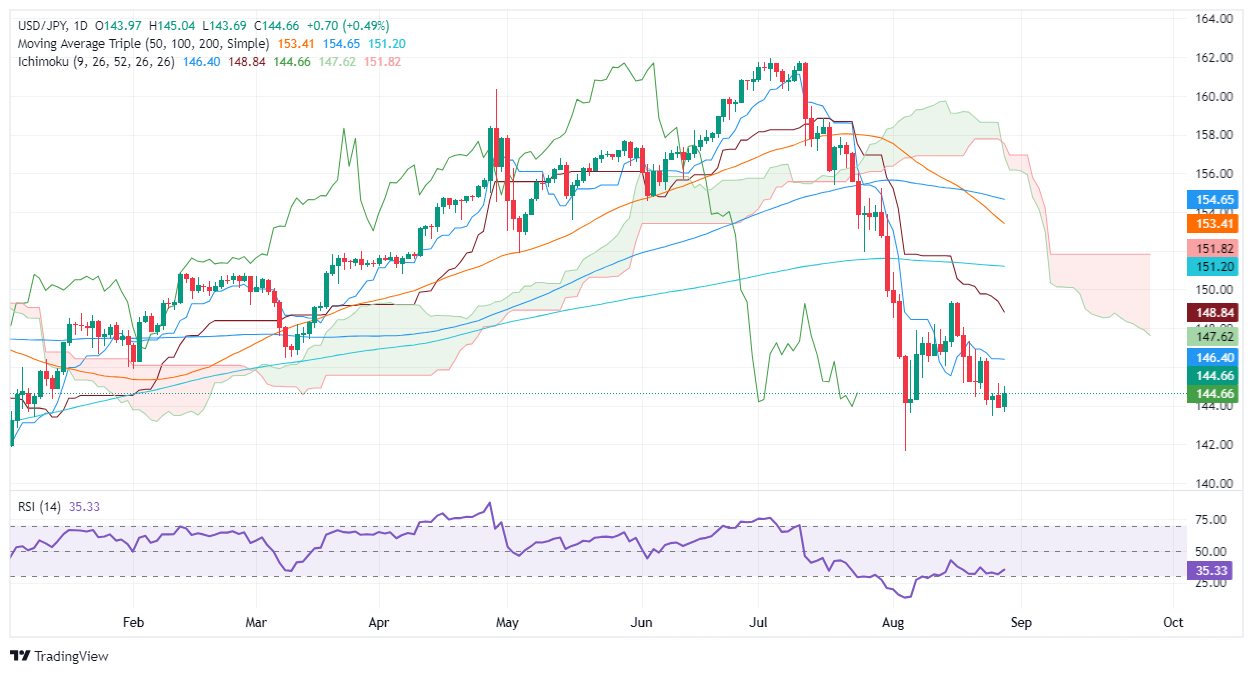- USD/JPY is up 0.50%, crossing 144.00; the downtrend persists with limited momentum for further gains.
- Key resistance at 145.00 is crucial for bullish continuation; next targets are 146.39 (Tenkan-Sen), 146.48 and 148.84 (Kijun-Sen).
- If 145.00 is not breached, it could retest 144.00 with supports at 143.44 (Aug. 26 low) and 141.69 (Aug. 5 low).
USD/JPY reverses course and posts decent gains of over 0.50% on Wednesday as the Dollar gains some momentum, though remains vulnerable to crucial data releases over the rest of the week. The pair is trading at 144.73 after bouncing off daily lows of 143.68.
USD/JPY Technical Outlook
The bearish trend in USD/JPY remains intact, although buyers stepped in and pushed the exchange rate above 144.00, with buyers unable to decisively break the 145.00 figure. The momentum suggests that sellers have lost some steam as the Relative Strength Index (RSI) is pointing higher, but they remain in command.
For a bullish continuation, USD/JPY buyers need to reclaim 145.00. Once clear, the Tenkan-Sen at 146.39 would be next, followed by the March 11 daily low turned resistance at 146.48 and the Kijun-Sen at 148.84.
Conversely, if USD/JPY sustains below 145.00, this could pave the way for a test of the 144.00 figure. Further downside lies the August 26 low at 143.44, followed by the latest cycle low at 141.69, the low of August 5.
USD/JPY Price Action – Daily Chart
Japanese Yen FAQs
The Japanese Yen (JPY) is one of the most traded currencies in the world. Its value is determined broadly by the performance of the Japanese economy, but more specifically by the policy of the Bank of Japan, the spread between Japanese and US bond yields, and risk sentiment among traders, among other factors.
One of the Bank of Japan’s mandates is currency control, so its moves are key to the Yen. The BoJ has intervened directly in currency markets on occasion, usually to lower the value of the Yen, although it often refrains from doing so due to political concerns of its major trading partners. The BoJ’s current ultra-loose monetary policy, based on massive stimulus to the economy, has caused the Yen to depreciate against its major currency peers. This process has been exacerbated more recently by a growing policy divergence between the BoJ and other major central banks, which have opted to sharply raise interest rates to combat decades-old levels of inflation.
The Bank of Japan’s stance of maintaining an ultra-loose monetary policy has led to an increase in policy divergence with other central banks, in particular with the US Federal Reserve. This favours the widening of the spread between US and Japanese 10-year bonds, which favours the Dollar against the Yen.
The Japanese Yen is often considered a safe haven investment. This means that in times of market stress, investors are more likely to put their money into the Japanese currency due to its perceived reliability and stability. In turbulent times, the Yen is likely to appreciate against other currencies that are considered riskier to invest in.
Source: Fx Street
I am Joshua Winder, a senior-level journalist and editor at World Stock Market. I specialize in covering news related to the stock market and economic trends. With more than 8 years of experience in this field, I have become an expert in financial reporting.








